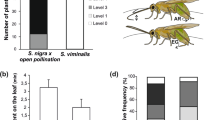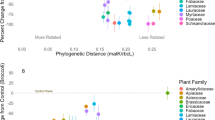Abstract
The stem-galling sawfly Euura lasiolepisuses one or more plant wound compounds resulting from oviposition scars as cues in host discrimination (avoiding sites occupied by conspecifics). Four experiments were conducted to test hypotheses about how Euurapartitions resources. Experiment 1 demonstrated that Euuraavoids ovipositing on nodes with scars from previous ovipositions. Experiment 2 showed no evidence that the sawfly uses oviposition-deterring pheromones and indicated there is a time lag following oviposition before the oviposition scar becomes a deterrent. Experiment 3 showed that sawflies avoid artificially formed scars, demonstrating that a plant cue alone can lead to host discrimination. Experiment 4 showed that visual or tactile cues are not necessary for host discrimination and indicated that a plant wound compound functions as an oviposition deterrent. Both experimental results and field surveys showed that Euuraoviposition scars were more uniformly distributed than expected if sawflies were ignoring previous ovipositions.
Similar content being viewed by others
References
Benson, W. W., Brown, K. S., and Gilbert, L. E. (1975). Co-evolution of plants and herbivores: Passion flower butterflies.Evolution 29: 659–680.
Brower, J. E., and Zar, E. H. (1984).Field and Laboratory Methods for General Ecology, 2nd ed., Wm. C. Brown, Dubuque Iowa.
Cirio, U. (1971). Reperti sul meccanismo stimolo-riposta nell ovideposizione delDacus oleae Gmelin.Redia 52: 577–600.
Craig, T. P., Price, P. W., and Itami, J. K. (1986). Resource regulation by a stem-galling sawfly on the arroyo willow.Ecology 67: 419–425.
Craig, T. P., Price, P. W., Waring, G., Clancy, K. M., and Sacchi, C. F. (1988). Forces preventing coevolution in the three trophic level system: Willow, a gall-forming herbivore, and parasitoids. In Spencer, K. (ed.),Chemical Mediation of Coevolution, Academic Press, New York, pp. 57–79.
Girolami, V., Vianello, A., Strapazzon, A., Ragazzi, E., and Veronese, G. (1981). Ovipositional deterrents inDacus oleae.Entomol. Exp. Appl. 29: 177–188.
Miller, J. R., and Strickler, K. L. (1984). Finding and accepting host plants. In Bell, W. J., and Cardé, R. T. (eds.),Chemical Ecology of Insects, Sinauer, Sunderland, Mass., pp. 127–157.
Price, P. W., and Clancy, K. M. (1986). Multiple effects of precipitation onSalix lasiolepis and populations of the stem-galling sawfly,Euura lasiolepis.Ecol. Res. 1: 1–14.
Price, P. W., and Craig, T. P. (1984). Life history, phenology, and survivorship of a stem-galling sawflyEuura lasiolepis (Hymenoptera: Tenthredinidae), on the arroyo willow,Salix lasiolepis.Ann. Ecol. Soc. Am. 77: 712–719.
Prokopy, R. J. (1981a). Epideictic pheromones that influence spacing patterns of phytophagous insects. In Nordlund, D. A., Jones, R. L., and Lewis, W. J. (eds.).Semiochemicals: Their Role in Pest Control, Wiley Press, New York, pp. 181–213.
Prokopy, R. J. (1981b). Oviposition-deterring system of apple maggot flies. In Mitchell, E. R. (ed.),Management of Insect Pests with Semiochemicals, Plenum Press, New York, pp. 447–494.
Prokopy, R. J., Roitberg, B. D., and Averill, A. L. (1984). Resource partitioning. In Bell, W. J., and Cardé, R. T. (eds.),Chemical Ecology of Insects, Sinauer, Sunderland, Mass., pp. 301–330.
Renwick, J. A. A., and Radke, C. D. (1980). An oviposition deterrent associated with frass and feeding larvae of the cabbage looper,Trichoplusia ni (Lepidoptera: Noctuidae).Environ. Entomol. 9: 318–320.
Renwick, J. A. A., and Radke, C. D. (1981). Host plant constituents as oviposition deterrents for the cabbage looper, Trichoplusia ni.Entomol. Exp. Appl. 30: 201–204.
Renwick, J. A. A., and Radke, C. D. (1982). Activity of cabbage extracts in deterring oviposition by the cabbage looper,Trichoplusia ni. In Visser, J. A., and Minks, A. K. (eds.),Proc. 5th Int. Symp. Insect-Plant Relation., Pudoc, Wageningen, The Netherlands, pp. 139–143.
Roitberg, B. D., and Prokopy, R. J. (1984). Host discrimination by adult and larval european apple sawfliesHoplocampa testudinea (Klug) (Hymenoptera: Tenthredinidae).Environ. Entomol. 13: 1000–1003.
Rothschild, M., and Schoonhoven, L. M. (1977). Assessment of egg load byPieris brassicae.Nature 266: 352–355.
Shurr, K., and Holdaway, F. G. (1970). Olfactory responses of femaleOstrinia nubilalis (Lepidoptera: Pyraustinae).Entomol. Exp. Appl. 13: 455–461.
Whitham, T. G. (1979). Territorial behavior ofPemphigus gall aphids.Nature 279: 324–325.
Williams, A. L., Mitchell, E. R., Heath, R. R., and Barfield, C. S. (1986). Oviposition deterrents for fall armyworm (Lepidoptera: Noctuidae) from larval frass, corn leaves, and artificial diet.Environ. Entomol. 15: 327–330.
Author information
Authors and Affiliations
Rights and permissions
About this article
Cite this article
Craig, T.P., Itami, J.K. & Price, P.W. Plant wound compounds from oviposition scars used in host discrimination by a stem-galling sawfly. J Insect Behav 1, 343–356 (1988). https://doi.org/10.1007/BF01054497
Accepted:
Issue Date:
DOI: https://doi.org/10.1007/BF01054497




